MINOLTA SLR LENS MOUNTS
Thanks to the longevity of the Minolta lens mount, every manual-focus
Minolta-style lens will fit on any Minolta-style manual-focus camera. Even
the oldest Minolta lens (1958 Auto Rokkor and Rokkor) will fit and function
on the newest Minolta camera (2004 X-370). Reciprocally, the newest
manual-focus Minolta lenses (2006 MD Minolta) will fit and function on the
oldest manual-focus Minolta camera (1958 SR-2). No other SLR camera
company can make this claim! Not Nikon, not Canon, not Leica. Not
nobody -- except Minolta.
All the other camera companies either stopped making SLR cameras or they
made substantial changes to their lens mount along the way. This prevents
their newer lenses from working on their older cameras, and vice versa.
For example, Pentax, Yashica, Mamiya, Olympus, Fuji and several others
all started their SLR camera lines with screw-mount lenses. They eventually
had to make the switch to the much-more-convenient, bayonet mount in order
to allow their lenses and camera to adequately "talk" to each other. Since
a screw-mount lens rotates several times while it is being attached to the
camera body, it is difficult to incorporate fixed linkages designed to mate
with static pins in the camera. Plus, it's a time-consuming,
pain-in-the-butt to put on! And without the best convenience features,
the screw-mount cameras could not compete for customers against the feature-rich
Minolta cameras. They were merely fodder for the trash heap of photographic
history.
So these camera companies eventually switched away from the screw-mount,
but their older screw-mount lenses will not work on their newer camera bodies
without an adapter -- and then they only function in a limited capacity.
And don't even think about putting one of their new lens on one of
their older cameras -- adapters are not available. So if you had an
old camera, and they developed a new lens, you were just out of luck.
Similarly, although Nikon used a bayonet system from the beginning, they
finally were forced to switch from their original, awkward, manual,
meter-coupling system of the F camera, to the convenient, spring-loaded,
Minolta-like AI system. This left Nikon's older lenses in the dust
bin. They will only work on the newer cameras with an expensive fix.
And how about Canon? Well, they started out with a frustrating,
breech-lock system that requires three hands to change a lens. They,
too, eventually gave it up and went to the sensible bayonet system, like
Minolta's, that allows you to change lenses in the dark -- with one hand.
In short, Minolta got it right from the beginning. They avoided all
of these problems when they created their original lensmount and lens design.
The original Minolta lenses, more often than not, had the aperture ring right
next to the camera body. Most other camera companies placed this ring
out toward the front of the lens, assuming that this was somehow convenient
for the user. When it came time for lenses and cameras to talk to each
other -- for metering and auto-exposure purposes -- the original Minolta
designs left them well ahead of the game. They had only to make relatively
minor adjustments to their lenses while everyone else had to "go back to
the drawing board" and come up with completely new lens series -- infuriating
many of their loyal customers.
Since automatic lenses remain at the maximum aperture, the meter in the camera
has no way of knowing what the f-stop is set at. The meter cannot compute
the correct exposure unless it knows what the final f-stop setting will be.
Most companies got around dilemma this by using "stop-down" metering.
In this approach, you have to press a lever (on the camera or the lens)
to stop-down the lens, and at that point the meter can take a reading..
Not only is this awkward, but it defeats the whole purpose of an automatic
lens system -- to keep the lens open and the viewfinder bright until the
moment of exposure. Minolta was able to avoid this whole problem of
"stop-down" metering because they had designed most of their lenses, from
the beginning, to have the aperture ring next to the camera body. All
Minolta had to do was make a minor modification to the f-stop ring on their
lenses to tell the meter what the f-stop was set at. It's the same
thing with f-stop displays in the camera viewfinder. This feature was
easy for Minolta to add because the f-stop ring on Minolta's lenses was located
next to the pentaprism from the very beginning. Other camera firms
came up with excuses and expensive fixes.
In summary, while Minolta's older lenses do not have all of the automatic
features of the newer lenses and cameras, they are still very usable on the
newest cameras. But just because you can get a particular Minolta lens to
physically attach to a particular Minolta camera does not mean that all of
the features of the lens or the camera will be usable. For example,
if you put a new lens on an old camera, the new features of the lens may
not be usable. Conversely, if you put an old lens on a new camera,
the new features of the camera might not be usable. This page provides details
on using cameras and lenses of different eras.
Minolta did made changes to their lens mount over time that provided certain
improvements to the lenses's features or improved their ease of use. None
of these changes to the lensmount directly improved picture quality, although
the new features might improve a photographer's ability to use the lens
correctly. The Minolta lens mount can generically be called the "SR"
mount or the "Minolta Manual Mount" (to distinguish it from that used on
Minolta's autofocus cameras). But since there are a number of variations,
they can be categorized as follows:
-
SR -- The SR mount is the basic mount to fit most of Minolta's SLR lenses
to the camera and first appeared in 1958. The
basic feature of the lens is the three-pronged bayonet mount (red arrows)
with a lock-tab in one of the bayonets. (The tab by the black arrow is the
preset lever, but not all lenses used this feature.) The SR mount is used
on many of Minolta's early lenses, but is also used on many later Minolta
lenses that did not require special connections to the camera, such as mirror
lenses which lack diaphragms, and bellows lenses which lack automatic diaphragms.
This lens mount lacks any pin or tab which pass lens settings to the
camera. Most of the lenses in the Rokkor series use this mount, and some
of the lenses in the MC Rokkor, MC Rokkor-X, MD Rokkor-X, and MD Minolta
era use this mount.
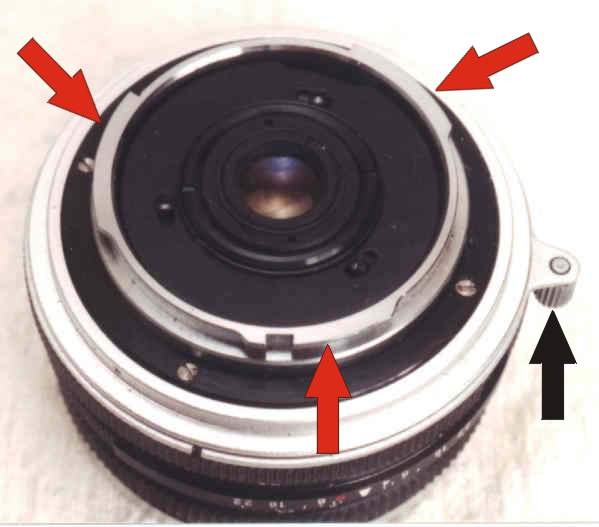
-
SR2 -- This mount appeared at the same time as the SR mount and has all of
the features of the SR mount, with the additional feature of an automatic
diaphragm operation. It is named after the Minolta SR-2 which was the
first Minolta SLR camera to offer this feature. A pin (blue arrow)
connects with a tab in the camera which keeps the lens diaphragm open until
the moment of exposure. The pin rotates on a plate on the rear of the lens
(blue arrows). (The tab by the black arrow is the f-stop lock lever, but
not all lenses used this feature.) This mount was short-lived and only available
on the earliest Auto-Rokkor lenses. It was soon replaced by the SR3 mount.
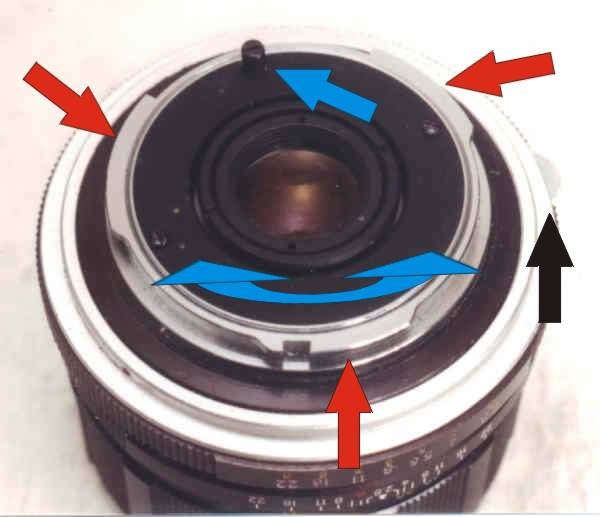
-
SR3 -- This mount appears in 1961 and is an improved version of the SR2 mount.
It is named after the Minolta SR-3 which was the first Minolta camera
to offer this mount. Specifically, while the SR2 mount has its aperture
linkage on a rotating, external plate, the SR3 has an internal, laterally
moving linkage. The SR2 approach proved inadequate to handle the speed of
the fully-automatic aperture operation of the SR-3, and Minolta modified
the mechanism to shorten its needed range of motion. Some other lens features
changed as well. (The tab by the black arrow is the stop-down lever, but
not all lenses used this feature.) Most of the lenses in the Auto-Rokkor
series use this mount, and a few of the lenses in the MC Rokkor-X, MD Rokkor-X,
and MD Minolta eras use this mount.
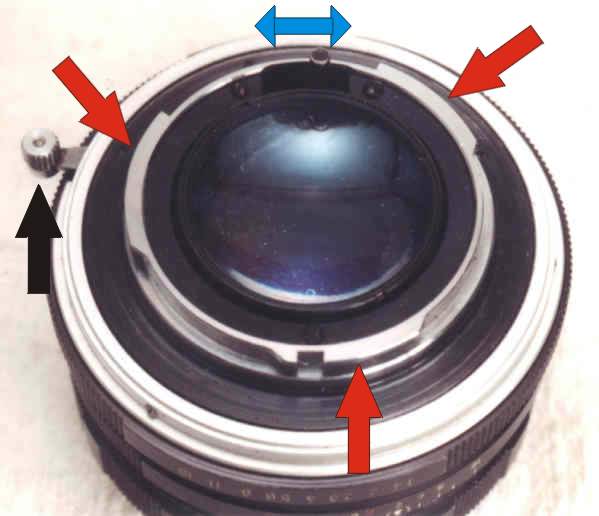
-
SRT -- This mount first appeared in 1966 and has all of the features of the
SR3 mount, with the addition of meter-coupling operation. The green
arrow points to the MC (meter-coupling) tab. It connects to the meter in
the camera and tells the meter how much to change the exposure as the lens
is "stopped-down" -- even though the diaphragm actually stays in the fully
opened position. It is named after the Minolta SRT line of cameras
which were the first Minolta cameras to offer this feature. This mount was
available only on the MC Rokkor line of lenses. (Some, but not all, lenses
with this mount had a stop-down lever, as seen above and below.)
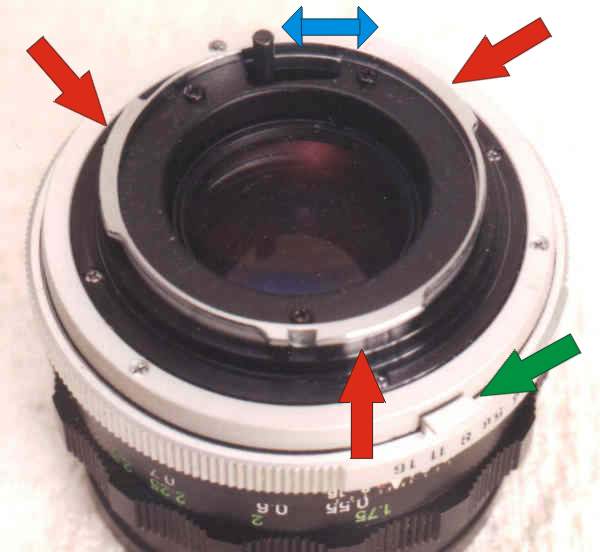
-
SRX -- This mount first appeared in 1972 and has all of the features of the
SRT mount, with the additional feature of displaying the aperture setting
in the viewfinder in cameras that were equipped to display it.. It is named
after the Minolta XK camera which was the first Minolta camera to offer this
viewfinder display feature. Earlier lenses were not designed to display their
settings in the viewfinder, although many of them happen to have their f-stop
scale in the right location. This mount standardized the location (yellow
arrow). All of the lenses in the MC Celtic series, most of the lenses
in the MC Rokkor-X series , and some of the lenses in the MD Rokkor-X, MD
Minolta, and earlier MC Rokkor series use this mount. (The tab by the black
arrow is the stop-down lever, but not all lenses used this feature.)
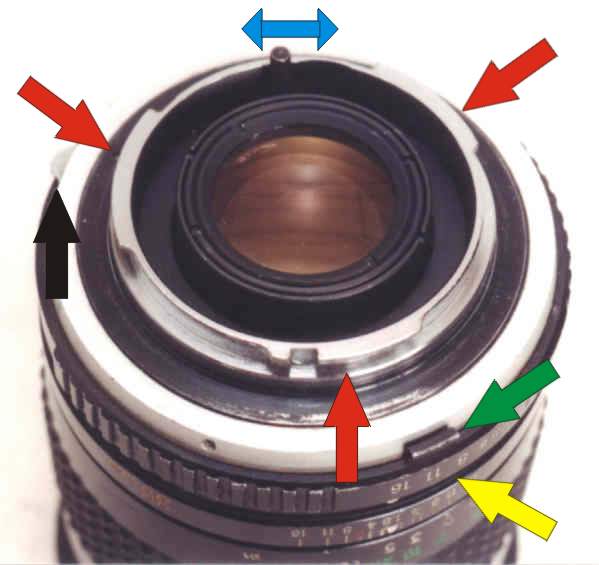
-
SRD -- This mount first appeared in 1977 and has all of the features of the
SRX mount, with the additional feature to support the new shutter-preferred,
auto-exposure option of the Minolta XD-11. This is referred to as an MD lug
(pink arrow) and is used to display correct exposure information in the
viewfinder when using the shutter-preferred exposure mode. All it does
is indicate to the meter what the minimum aperture of the lens is -- f16,
f22, or f32. When the lens is set at the minimum f-stop, and the camera is
set for shutter-preferred automatic exposure, this lug allows the meter to
accurately display the f-stop (that will be set automatically) in the viewfinder.
It is named after the Minolta XD-11 camera which was the first Minolta camera
to offer this feature. All of the lenses in the MD Celtic series, most of
the lenses in the MD Rokkor-X, and some of the lenses in the MD Minolta series
use this mount.
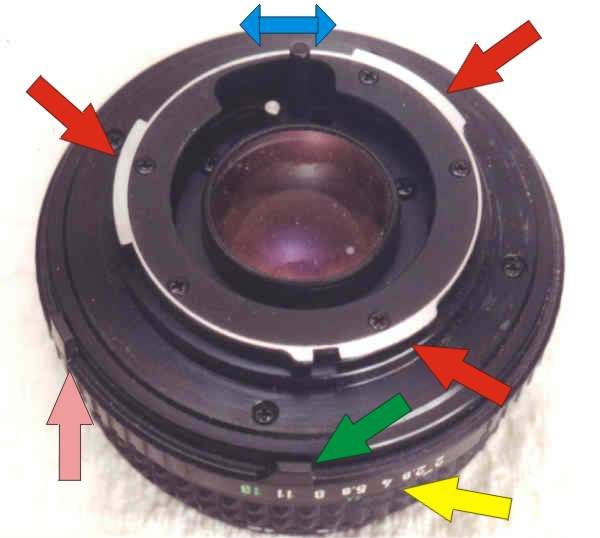
-
SRM -- This mount first appeared in 1981 and has all of the features of the
SRD mount, with the additional feature to support the focus-assist feature
of the Minolta X-600. It is named after the Minolta line of lenses
which were no longer called "Rokkor". They were simply called "Minolta".
The tab is very small, easily overlooked (white arrow), and completely irrelevant
in all Minolta cameras except the X-600. Most of the lenses in the MD Minolta
series use this mount.
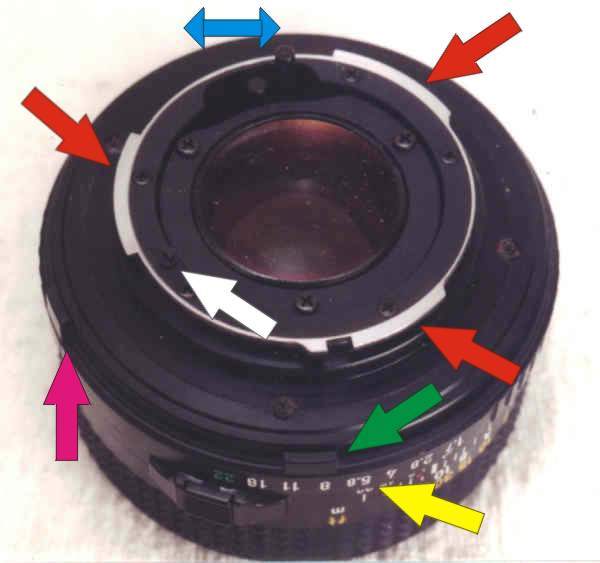
-
SRL -- This mount first appeared in 1961 and isn't really a "Minolta" mount
at all. It is a standard Leica thread mount, just like the thread that is
used for many enlarging lenses. Why is it mentioned here? Because Minolta
made a couple of SLR lenses with a Leica screw-mount. Why would they
do that? There is a lot of speculation about this, but most of it is just
that. Some suggest that Minolta made the lens to be used on Leica cameras.
Although this lens can be used on Leica screw-mount cameras, it's extremely
doubtful that any Leica users of the time (1960's) would consider using a
"cheap" Minolta lens on their very expensive cameras. This rumor probably
developed due to the later cooperative manufacturing and sales agreements
that Minolta and Leica forged. In fact, Minolta did make many lenses for
Leica cameras, but this happened much later -- in the 1970's. Instead, Minolta
probably gave these lenses a Leica thread due to the special nature
of the lenses and the hope that it would expand their market share. This
SLR thread was only used by Minolta on a Macro lens and a Bellows lens --
two lenses that Minolta needed to produce, but which had very low sales
potential. Because they were both non-auto-diaphragm lenses, it was a simple
matter to produce the lens in a Leica thread -- a thread that users of other
cameras could easily use with an adapter. In fact, when these lenses were
purchased they came with a Minolta L-adapter as standard equipment.
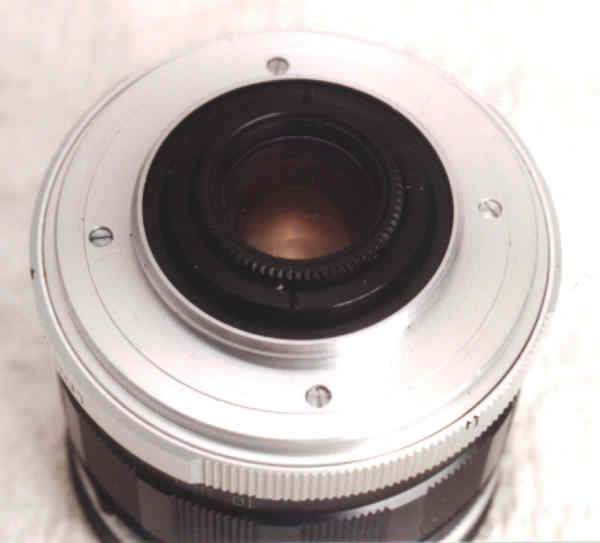
-
SRB -- This mount first appeared in 1974, and like the SRL mount, this isn't
really a "Minolta" mount either. It is a screw-mount that is commonly used
on microscope lenses (0.8 inch / 20.32mm thread). Why is it mentioned
here? Minolta made a few SLR lenses with a microscope screw-mount. Why
would they do that? The lenses that have this mount are very small, such
as the 12.5mm bellows lens. It's about the size of your thumb. The normal
mount could be used if these lenses would only be used on a camera or bellows,
but Minolta knew that photographers would want to use these lenses on a
microscope. The only way to make that happen was to use a smaller mount,
and the standard microscope mount is perfect. These lenses are used on a
camera or bellows with the use of a Minolta M, M1, or M2 adapter.
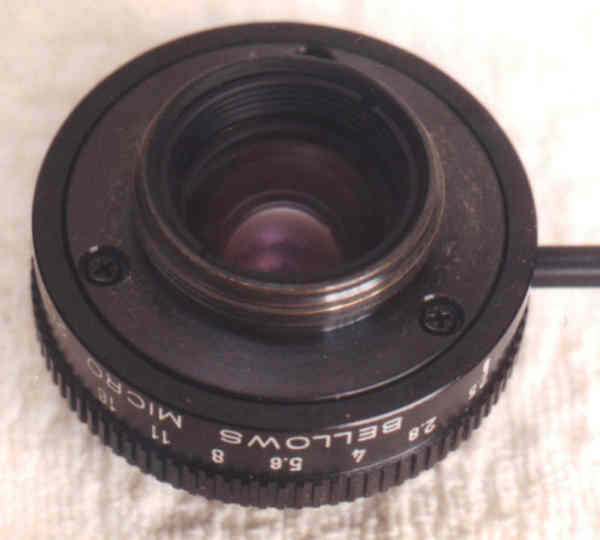
You can use any Minolta SLR lens from an earlier
series on any later camera but you will lack the features of the later lens
series that were designed for that later camera. Likewise, you can
use any lens from a later series on an earlier camera but you will lose the
new features of the later lens series. These tables will help you determine
which features, in any, you will lose.
WHICH LENSES HAVE WHICH LENS
MOUNTS?
Minolta Camera Mounts
| LENS SERIES |
SR |
SR2 |
SR3 |
SRT |
SRX |
SRD |
SRM |
SRL |
SRB |
| ROKKOR |
X |
- |
- |
- |
- |
- |
- |
X |
- |
| AUTO-ROKKOR |
- |
X |
X |
- |
- |
- |
- |
- |
- |
| MC ROKKOR |
X |
- |
X |
X |
- |
- |
- |
- |
- |
| MC ROKKOR-X |
X |
- |
X |
- |
X |
- |
- |
- |
X |
| MD ROKKOR-X |
X |
- |
X |
- |
X |
X |
- |
- |
X |
| MD MINOLTA |
X |
- |
X |
- |
X |
X |
X |
- |
X |
| MC CELTIC |
- |
- |
- |
- |
X |
- |
- |
- |
- |
| MD CELTIC |
- |
- |
- |
- |
- |
X |
- |
- |
- |
Minolta Lens and Camera Mount Limitations
| LENS SERIES |
SR
DESIGNED FOR THESE CAMERAS:
-- |
SR2 -- automatic diaphragm added
DESIGNED FOR THESE CAMERAS:
SR2, early SR1 |
SR3 -- lateral diaphragm pin added
DESIGNED FOR THESE CAMERAS:
SR3, late SR1 |
SRT -- meter-coupling added
DESIGNED FOR THESE CAMERAS:
SRT101,SRT100,SRT201,SRT200 |
SRX -- f-stop viewfinder display added
DESIGNED FOR THESE CAMERAS:
XK,SRT102, SRT202,XE-7,XG-M,XG-9 |
SRD -- shutter-preferred mode added
DESIGNED FOR THESE CAMERAS:
XD-11, XD-5. X-700 |
SRM -- focus-confirmation added
DESIGNED FOR THESE CAMERAS:
X-600 |
| ROKKOR |
None |
-
With these lenses, the viewfinder darkens when they are stopped-down because
they lack automatic diaphragms.
|
-
With these lenses, the viewfinder darkens when they are stopped-down because
they lack automatic diaphragms.
|
-
With these lenses, the viewfinder darkens when they are stopped-down because
they lack automatic diaphragms.
-
These lenses lack meter coupling. The camera meter must be used in
"stopped-down mode".
|
-
With these lenses, the viewfinder darkens when they are stopped-down because
they lack automatic diaphragms.
-
These lenses lack meter coupling. The camera meter must be used in
"stopped-down mode".
-
Some of these lenses lack proper positioning of the f-stop for display in
the viewfinder of cameras that are so equipped, such as the XK, SRT102, SRT202,
XG9 and others.
|
-
With these lenses, the viewfinder darkens when they are stopped-down because
they lack automatic diaphragms.
-
These lenses lack meter coupling. The camera meter must be used in
"stopped-down mode".
-
Some of these lenses lack proper positioning of the f-stop for display in
the viewfinder of cameras that are so equipped, such as the XK, SRT102, SRT202,
XG9 and others.
|
-
With these lenses, the viewfinder darkens when they are stopped-down because
they lack automatic diaphragms.
-
These lenses lack meter coupling. The camera meter must be used in
"stopped-down mode".
-
Some of these lenses lack proper positioning of the f-stop for display in
the viewfinder of cameras that are so equipped, such as the XK, SRT102, SRT202,
XG9 and others.
-
These lenses do not provide accurate focus confirmation on the X-600 camera,
although many report that they do not have problems with these lenses.
|
| AUTO-ROKKOR |
None |
None |
None |
-
These lenses lack meter coupling. The camera meter must be used in
"stopped-down mode".
|
-
These lenses lack meter coupling. The camera meter must be used in
"stopped-down mode".
-
Some of these lenses lack proper positioning of the f-stop for display in
the viewfinder of cameras that are so equipped, such as the XK, SRT102, SRT202,
XG9 and others.
|
-
These lenses lack meter coupling. The camera meter must be used in
"stopped-down mode".
-
Some of these lenses lack proper positioning of the f-stop for display in
the viewfinder of cameras that are so equipped, such as the XK, SRT102, SRT202,
XG9 and others.
|
-
These lenses lack meter coupling. The camera meter must be used in
"stopped-down mode".
-
Some of these lenses lack proper positioning of the f-stop for display in
the viewfinder of cameras that are so equipped, such as the XK, SRT102, SRT202,
XG9 and others.
-
These lenses do not provide accurate focus confirmation on the X-600 camera,
although many report that they do not have problems with these lenses.
|
| MC ROKKOR |
None |
None |
None |
None |
-
Some of these lenses lack proper positioning of the f-stop for display in
the viewfinder of cameras that are so equipped, such as the XK, SRT102, SRT202,
XG9 and others.
|
-
Some of these lenses lack proper positioning of the f-stop for display in
the viewfinder of cameras that are so equipped, such as the XK, SRT102, SRT202,
XG9 and others.
|
-
Some of these lenses lack proper positioning of the f-stop for display in
the viewfinder of cameras that are so equipped, such as the XK, SRT102, SRT202,
XG9 and others.
-
These lenses do not provide accurate focus confirmation on the X-600 camera,
although many report that they do not have problems with these lenses.
|
| MC ROKKOR-X |
None |
None |
None |
None |
None |
-
On these lenses, the automatically selected aperture will not be displayed
in the viewfinder in "S" mode with the XD-11. It is selected correctly
on all models, but not displayed.
|
-
These lenses do not provide accurate focus confirmation on the X-600 camera,
although many report that they do not have problems with these lenses.
|
| MD ROKKOR-X |
None |
None |
None |
None |
None |
None |
-
These lenses do not provide accurate focus confirmation on the X-600 camera,
although many report that they do not have problems with these lenses.
|
| MD MINOLTA |
None |
None |
None |
None |
None |
None |
None |
| MC CELTIC |
None |
None |
None |
None |
None |
-
On these lenses, the automatically selected aperture will not be displayed
in the viewfinder in "S" mode with the XD-11. It is selected correctly
on all models, but not displayed.
|
-
These lenses do not provide accurate focus confirmation on the X-600 camera,
although many report that they do not have problems with these lenses.
|
| MD CELTIC |
None |
None |
None |
None |
None |
None |
-
These lenses do not provide accurate focus confirmation on the X-600 camera,
although many report that they do not have problems with these lenses.
|
If you are able to provide additional information, please contact us at
xkaes@aol.com.
RETURN TO THE MANUAL MINOLTA HOME PAGE
We didn't want to do this, but since other websites have been stealing our
stuff, we have no alternative but to state:
COPYRIGHT@1995,1996,1997,1998,1999,2000,2001,2002,2003,2004, 2005 by Joe
McGloin. All Rights Reserved.

















